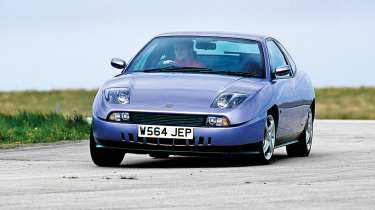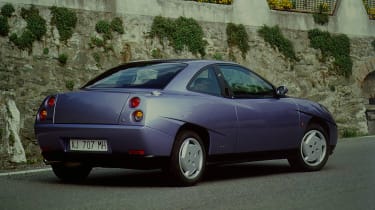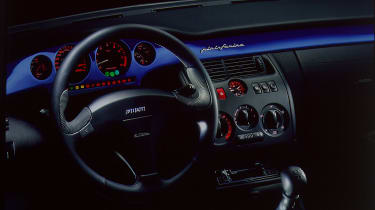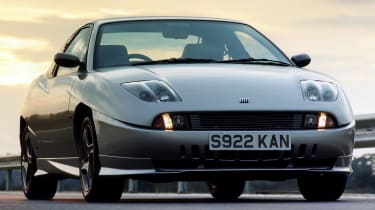Fiat Coupe – review, history, prices and specs
One of the most iconic shapes of the 1990s, the Fiat Coupe was also technically intriguing
Walk into a Fiat dealership today and you’ll find a handful of Pandas, plenty of 500s, and then a selection of vehicles that look like a 500 that’s really let itself go. Without the short-lived 124 Spider and the growling Abarths, it’s a bit of a sorry sight.
If you’d done the same in the late 1990s you’d be faced with a rather different line-up. Facing you would be a smattering of bright yellow Cinquecentos, primary colour Puntos, Bravos (and Bravas), perhaps the googly eyed Multipla if you’ve time-hopped to the right year, and of course, a pair of eye-catching, low-slung sports cars: the pretty open-topped Barchetta and the angular, slash-arched Fiat Coupe.
> New Fiat 500 launched with all-electric powertrain
Fiat really was on a roll in the last decade of the 1900s, and it was the Coupe, revealed to the public in late 1993, that spearheaded the charge. Like the Barchetta it lasted only one generation, and while its underpinnings were humble, its junior-Ferrari appeal gave the brand a halo car it hasn’t been able to replicate since, even with the recent Fiat 124 Spider.
Fiat Coupe in detail
The Coupe’s genesis was a matter of fortuitous circumstance. Faced with the prospect of a dormant factory due to the failure of the Cadillac Allante it was building, Pininfarina pitched Fiat the idea of building a new coupe at the facility. It would be based on Fiat’s ‘Type Two’ platform – a front-wheel-drive layout conceived for the Tipo, and one that eventually ended up underpinning most of the Alfa Romeo range through the 1990s and early 2000s.
Both Pininfarina and Fiat itself through its Centro Stile design house competed to pen the new car, with the latter winning out. The designer responsible for the car’s look was a certain Chris Bangle, whose other work at Centro Stile included the Alfa Romeo 145. Pininfarina would indeed build the car though, and its designers also styled the interior.
Inside and out it was a remarkable shape, the exterior lines defined by a low snout with curvaceous headlight housings, by dramatic slashes above each wheelarch, and for its bluff, squared-off tail, with round, supercar-style sunken tail lights. The cabin was a little more conventional, but Pininfarina’s flair could be found in the strip of body-colour trim running the width of the dashboard, with deep-set dials echoing the look of those tail lights.
Type Two was, to its credit, relatively sophisticated for its day, ensuring the Coupe used independent suspension at both ends (MacPherson struts up front, trailing arms with coil springs at the rear). It was more useful still for engine choice, allowing Fiat to fit a development of the iron block, aluminium twin-cam head design that powered the Lancia Delta Integrale to multiple World Rally Championship titles.
In naturally aspirated form it made a healthy 142bhp, but the 195bhp turbocharged model was the real eye-opener, retaining the twin-cam character but putting more power to its front wheels than virtually any other front-wheel-drive car of the era.
Production began in 1993 with UK market deliveries starting in 1995 in an increasingly crowded coupe market. Alfa Romeo’s own Tipo-based coupe, the GTV, debuted the same year and joined the Fiat in comparison tests, and each frequently outranked other rivals due to their style, engaging powertrains and agile handling.
The Coupe’s powertrain would get even more eye-popping from 1996, when Fiat slotted an in-line five under the clamshell bonnet. Once again offered in both naturally aspirated and turbocharged forms, power and torque increased in both variants, with the 20v Turbo now making 220bhp and a massive 228lb ft of torque, elevating its straight-line speed - 0-60mph took only 6.4sec, and it was a true 150mph car - to that of a serious performance car.
The five-pot gave the Coupe a bump in sales, but as the ’90s progressed the Coupe slowly started to fade from the roads. A Limited Edition hit the UK in 1998, denoted by a bodykit that actually somewhat spoiled the Coupe’s clean lines, plus titanium grey wheels, red brake calipers, vibrantly trimmed Recaro seats, and a push-button start, a detail fairly unusual at the time.
Production ended in December 2000, by which time coupes as an entity were disappearing from view and hot hatchbacks, which had struggled throughout the 1990s, were making a resurgence. Within just a few years the roads were awash with Clio 172s, EP3 Civic Type Rs and MG ZRs. That’s not to mention the turbocharged Renault Sport Méganes, Leon Cupras and Focus RS – the only ones that got close to the 20v Turbo’s performance...
Specs (UK models)
| 16v | 16v Turbo | 20v | 20v Turbo | |
| Engine | 1995cc, 4-cyl | 1995cc, 4-cyl | 1998cc, 5-cyl | 1998cc, 5-cyl |
| Power | 142bhp @ 6000rpm | 195bhp @ 5500rpm | 147bhp @ 6100rpm | 220bhp @ 5750rpm |
| Torque | 135lb ft @ 4500rpm | 218lb ft @ 3400rpm | 137lb ft @ 4500rpm | 228lb ft @ 2500rpm |
| Weight | 1218kg | 1280kg | 1270kg | 1310kg |
|
Power-to-weight | 118bhp/ton | 155bhp/ton | 118bhp/ton | 171bhp/ton |
| 0-60mph | 9.0sec | 6.8sec | 8.3sec | 6.4sec |
| Top speed | 129mph | 140mph | 128mph | 150mph |
| Price | £17,348 (1995) | £19,249 (1995) | £20,205 (1999) | £22,855 (1999) |
What we said
Fiat Coupe 20v Turbo Limited Edition (evo 003, January 1999)
‘With the 20v motor’s grunty low-end torque and charging mid-range thrust, upshifts come thick and fast. Traction is surprisingly strong, even in the damp. There’s a viscous coupling in the front differential which tames wheelspin and torque-steer (unless you’ve got a clumsy right boot) and the steering is remarkably uncorrupted considering there’s 220bhp running through the front wheels.
‘The steering feel is a little wooden and you do get some kickback over bumps and lateral ridges under full power. That said, it’s still possible to guide the Fiat cleanly from one apex to the next, and you can adjust your line and the Coupe’s attitude with a lift of the throttle.’
What to pay
| 16v | £1000-3000 |
| 16v Turbo | £2000-5000 |
| 20v | £1500-4000 |
| 20v Turbo | £3000-8000 |







